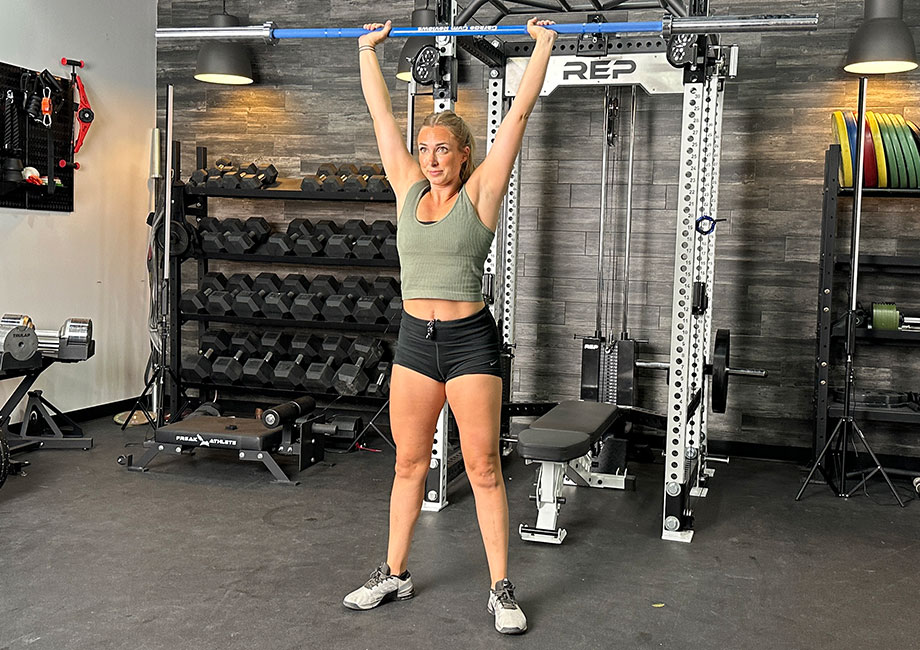We test and review fitness products based on an independent, multi-point methodology. If you use our links to purchase something, we may earn a commission. Read our disclosures.
The overhead press is one of the best shoulder exercises because it trains all three deltoid heads (anterior, lateral, and posterior delts), your chest, triceps, and lats. Also, when pressing heavy weight, you’ll be improving your size, strength, and flex appeal.
Here, I’ll dive into all things overhead press for all your bolder shoulder needs, along with form tips and variations from a longtime certified personal trainer (CPT), me.
Grab your barbell, and let’s get pressing.
RELATED: Best Olympic Barbell
How To Overhead Press
- Exercise name: Overhead press
- Exercise type: Compound
- Targeted muscles: Deltoids (shoulders)
- Secondary muscles: Triceps, trapezius, upper chest, abdominals
- Equipment needed: Barbell, dumbbells, or kettlebell
- Difficulty level: Intermediate to advanced
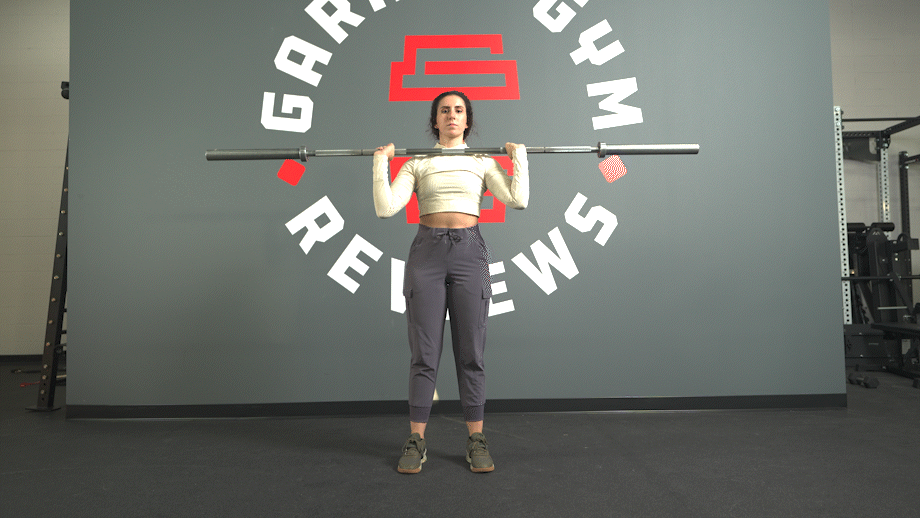
- In the standing position, grip the barbell with an overhand grip and set it up at shoulder height in the squat rack.
- Then, place your hands just outside of shoulder width and ensure your elbows and forearms form a straight line.
- Place the barbell in the heel of your palm, and your wrist is in neutral.
- Press overhead until lockout.
- Slowly lower to the starting position and reset and repeat for desired repetitions.
Trainer Tips for Form
The standing barbell overhead press is a full-body exercise, as many moving parts need to work together. If you’re a beginner, a landmine press, a resistance band, or a dumbbell overhead press is a good start. Here are some CPT tips (CPTips?) on good barbell overhead press form.
RELATED: Landmine Exercises
Correct Set-Up
The set-up is critical to press overhead with good form. Having the barbell in the heel of your palm and wrist in neutral is your strongest pressing position, and aligning your elbow and wrist allows for a better and straighter pressing path.
Good Shoulder Mobility
Pressing overhead and getting your biceps by your ears without excessive compensation from the anterior core and lower back is key for a safe press. Yes, you can still do it without, but be warned that your shoulder and back will eventually be unhappy.
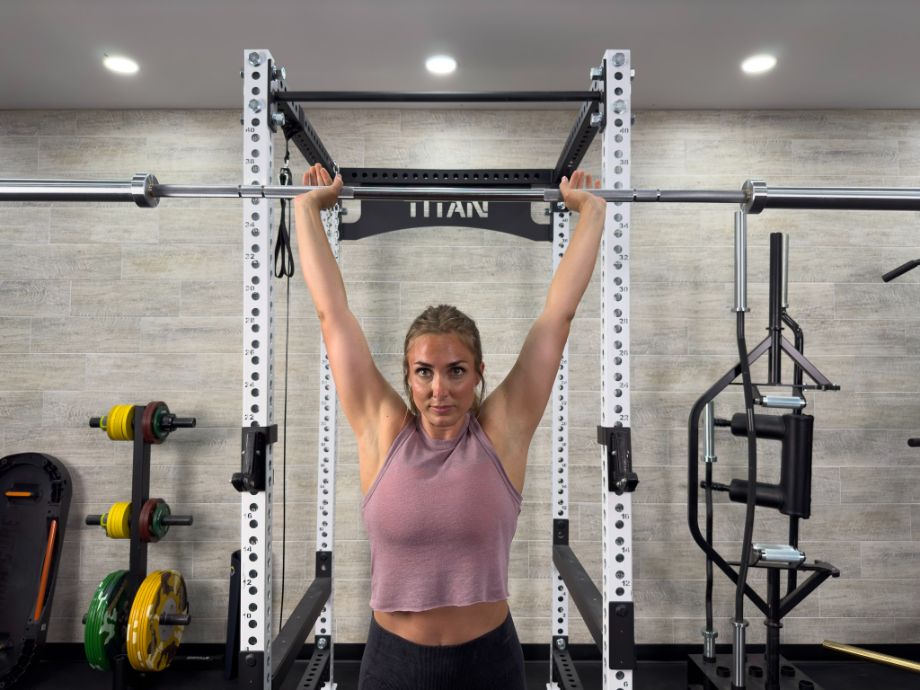
Brace It Baby
Having your anterior core engaged and your glutes locked in will give you a better base to press and stop the body compensations mentioned above.
Use a Spotter
You may not think of the overhead press as a “spotter exercise.” However, you can get an assist from your training partner by having them stand behind you and brace your upper arms as you press. They may also be able to keep you from stumbling backward.
RELATED: How to Be a Good Spotter
Overhead Press Variations
The standing barbell overhead press is an excellent exercise, but it helps to change things up to prevent The standing barbell overhead press is an excellent exercise, but it helps to change things up to prevent overuse injuries, reduce training boredom, and provide different stimuli1 to your shoulder muscles. Here are a few variations to add to your exercise toolkit.
Arnold Press
Why do it: Named after legendary bodybuilder Arnold Schwarzenegger, this variation adds a rotational component that targets all three heads of the deltoid muscle.
How to do it:
- Hold a dumbbell in each hand at shoulder height, with your palms facing your body.
- Press the dumbbells overhead, rotating your palms to face forward.
- Reverse the motion as you lower the dumbbells back to the starting position.
- Repeat for the desired number of repetitions.
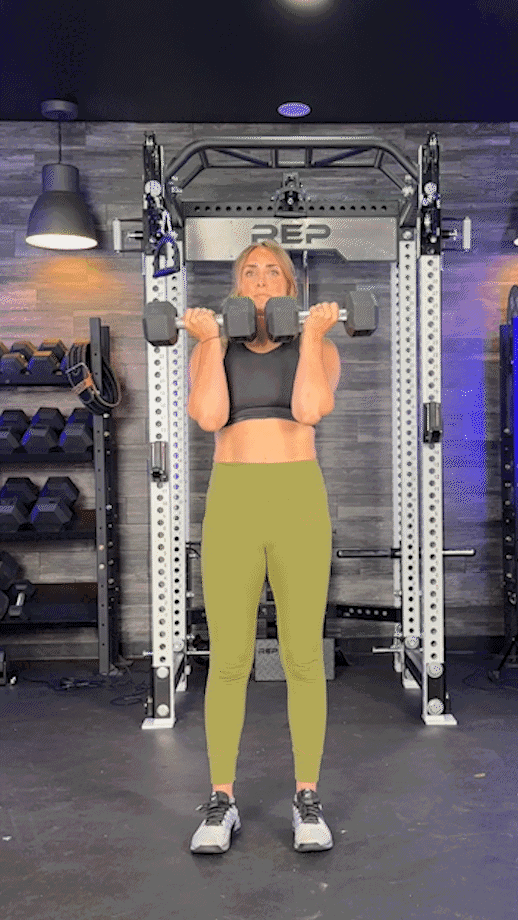
Push Press
Why do it: If you’re looking for a full-body variation, the push press incorporates leg drive to help lift heavier weights, making it a great exercise for building power2 and strength.
How to do it:
- Stand with your feet shoulder-width apart, holding a barbell at shoulder height.
- Dip your knees slightly, then extend your legs explosively while pressing the bar overhead.
- Lower the bar back to the starting position with control.
- Repeat for the desired number of repetitions.
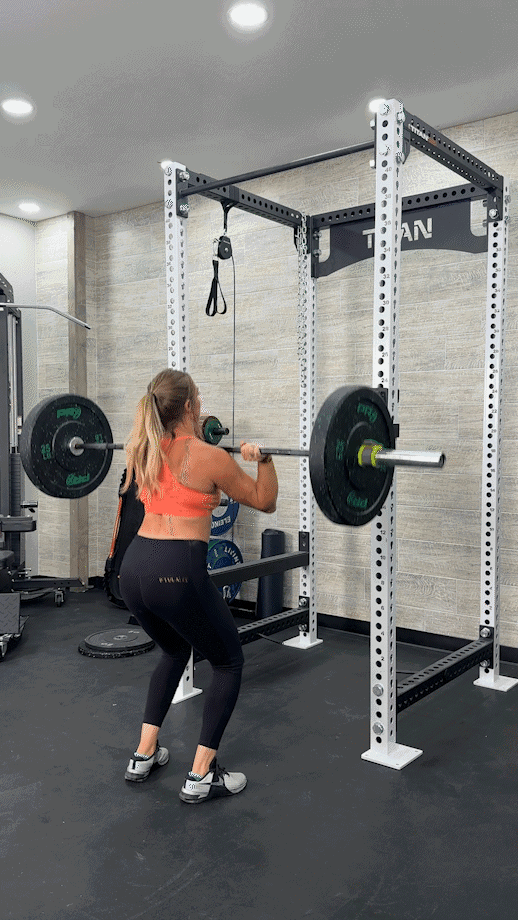
Behind-the-Neck Press
Why do it: This variation can increase shoulder flexibility and more effectively engage your rear deltoids and trapezius muscles than the standard version.
How to do it:
- Stand with your feet shoulder-width apart, holding a barbell behind your neck with a grip slightly wider than shoulder width.
- Engage your core, then press the barbell upward until your arms are fully extended.
- Lower the barbell back to the starting position.
- Repeat for the desired number of repetitions.
Shoulder Pin Press
Why do it: This overhead press variation focuses on the top half of the movement by helping you improve your lockout strength and triceps development.
How to do it:
- Set the safety pins in a squat rack at shoulder height.
- Position the barbell on the pins and stand with your feet shoulder-width apart.
- Press the barbell upward from the pins until your arms are fully extended.
- Lower the barbell back to the pins with control.
- Repeat for the desired number of repetitions.
Single-Arm Overhead Push Press
Why do it: Bilateral lifts like the barbell overhead press may hide strength imbalances. By pressing one side at a time (or unilaterally), you can help correct and strengthen both sides and potentially reduce an imbalance. Additionally, pressing with a dumbbell or kettlebell engages the rotator cuff because of the extra stability needed.
RELATED: Best Dumbbells
How to do it:
- Hold one dumbbell or kettlebell by your shoulder with a neutral grip and wrist and elbow aligned.
- Engage your anterior core and glutes.
- Dip your knees, explode up, and press overhead until your bicep is by or behind your ear.
- Slowly lower down to the starting position, reset, and repeat for desired reps.
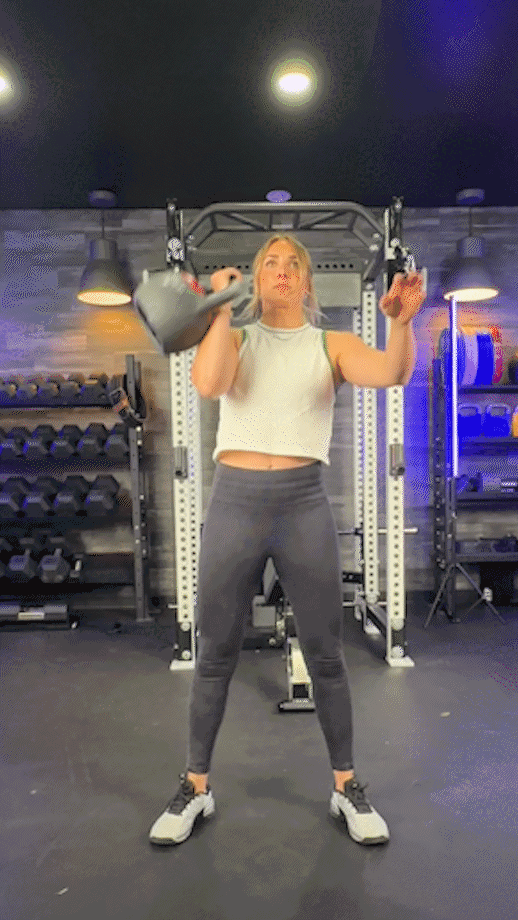
Seated Overhead Press (Military Press)
Why do it: The seated overhead press gives you more stability and focuses on the upper body because there is no lower body drive. This is an ideal variation if your lower back is bothering you.
How to do it:
- Sit upright on a bench (or chair) in front of a power rack with the barbell at shoulder height. If you don’t have a power rack, you can also perform this movement with dumbbells.
- Take a wider-than-shoulder-width grip and get your elbows underneath your wrists.
- Unrack the barbell and get your shoulders down and chest up.
- Press overhead until your biceps are behind or by your ears.
- Slowly lower down to the starting position, reset, and repeat for reps.
Trainer’s note: This variation is another great opportunity to recruit a training partner or spotter for extra support.
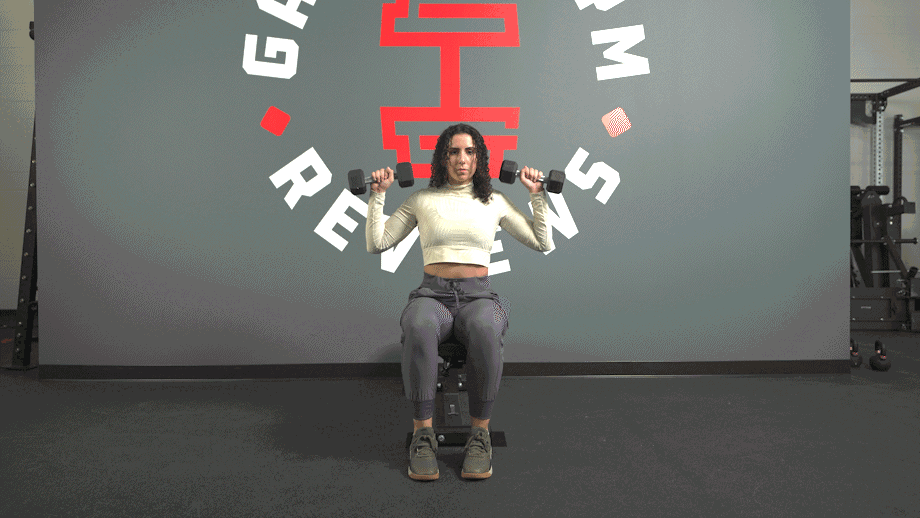
Standing Overhead Press Benefits
Besides getting stronger and looking fantastic, here are a few vital benefits of the overhead press.
Better Core Strength
Your anterior and posterior core muscles will strengthen when you prevent an excessive arch in the lower back and a flaring rib cage. Performing the overhead press well will strengthen your shoulders and improve your core stability and strength.
Hypertrophy
Performing lateral, front, and posterior delt raises will add some size and shape to your deltoids, but that will only take you so far. Heavier weight and progressive overload are needed, which the overhead press provides as it trains all three deltoid heads hard and heavy for bigger shoulders.
Better Pressing Technique
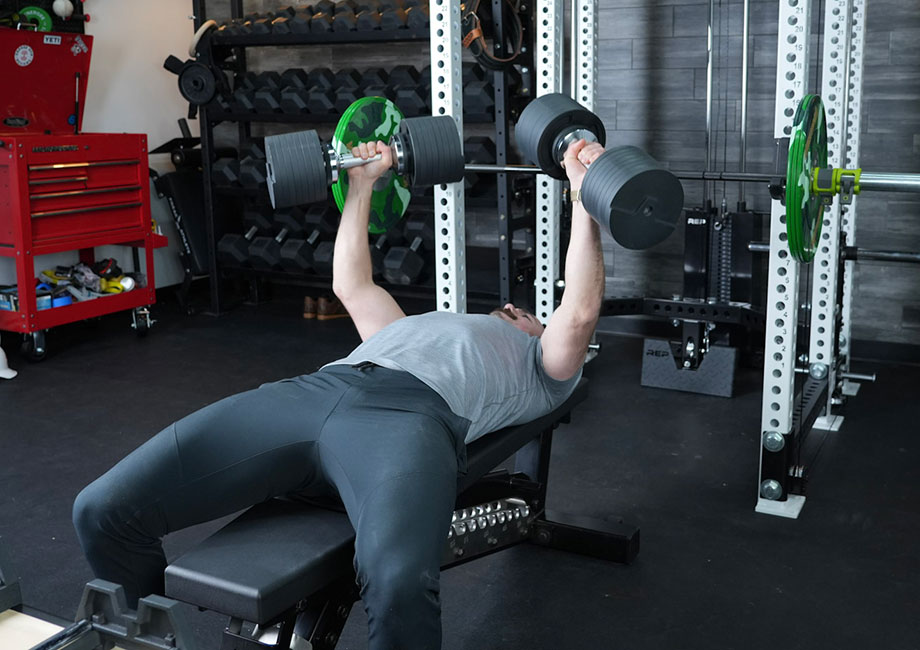
A solid overhead press will help your bench press and Olympic lifts because both use similar muscles from different angles. Upper back strength plays a vital role in the overhead press, and strengthening the upper back (lats, trapezius, and rhomboids) improves your bench press pressing path for more efficient technique. Upper back strength is also great for the deadlift as it keeps the barbell close to your body for a safer pull.
RELATED: Deadlift Muscles Worked
Common Overhead Press Mistakes
The biggest overhead press mistake is forcing a square peg into a round hole. If it doesn’t feel good for your shoulders or you lack the shoulder mobility to make it happen, perform a variation more suited to your needs. For instance, unilateral landmine presses.
Here are a few common mistakes to watch out for when trying to build better overhead press form and reduce your risk of injury.
Grip It
Not having the correct grip width means your wrists and elbows are aligned, and the barbell is not sitting in your hand well. If your hands are not just outside shoulder-width apart, elbows and forearms are not vertical, and the wrist is hyperextended, say hello to poor pressing form.
RELATED: Grip Strength Exercises
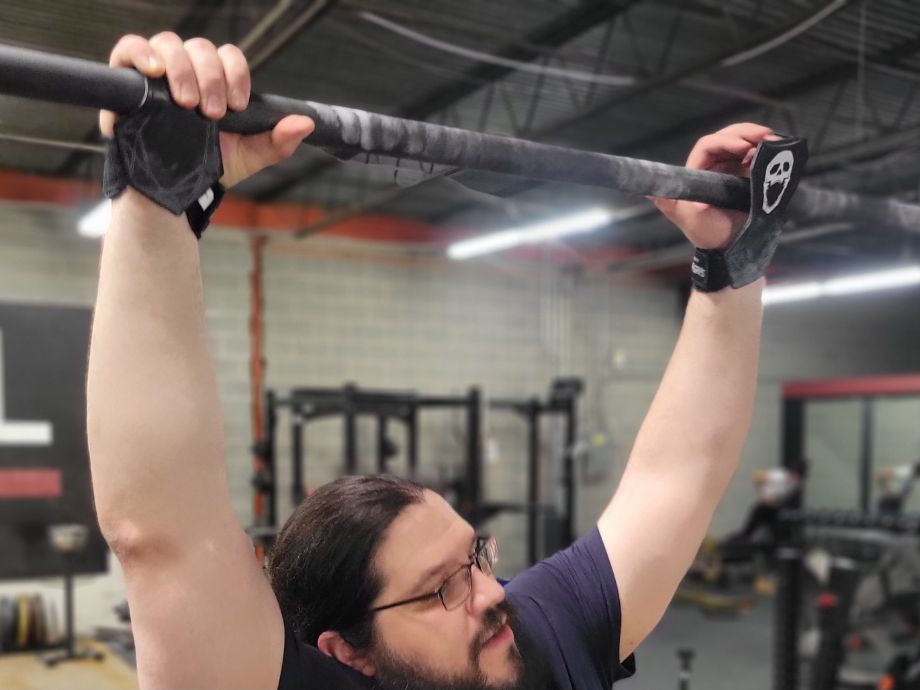
Loss Of Position
If your rib cage flares out and your lower back hyperextends in an attempt to press overhead, you’ve lost the ideal pressing path and increased your injury risk.
Your Head Is In The Way
You obviously cannot press the barbell through your head, and pressing around it messes up the pressing path. Similarly, not tucking your chin or moving your head forward at lockout messes with your bar path and reduces your range of motion.
Narrow Stance
Having your feet too close together doesn’t give you a stable base of support because it reduces your stability. Can you imagine losing your balance with weights overhead? Yes, I should stop now.
Safety Tips And Precautions
Performing the overhead press requires precise technique. These form tips and precautionary measures can help you stay safe.
- Warm-up properly: Before performing the overhead press, ensure you have adequately warmed up your shoulders, upper back, and arms. Dynamic stretches and mobility exercises with resistance bands can help prepare these muscle groups.
- Maintain proper form: Keep a neutral spine and engage your core throughout the movement to avoid an excessive lower back arch. Your wrists should be straight, and your elbows slightly forward.
- Start with light weights: Begin with lighter weights to master the technique before gradually increasing the load. This helps prevent strain and injuries.
- Use a full range of motion: Lower the bar to your collarbone or just below your chin and press up until your arms are almost fully extended.
- Avoid locking out your elbows: Do not fully lock out your elbows at the top of the movement. Instead, keep a slight bend to maintain muscle tension and protect your joints.
- Breathe properly: Inhale before lifting the bar and exhale as you press it overhead. Proper breathing helps stabilize your core and maintain balance.
Check your grip width: Your hands should be shoulder-width apart or slightly wider. Going too wide or too narrow can cause undue stress on your shoulders.
Overhead Press Strength Standards
Curious to see how you measure up against other pressers? These strength standard charts from ExRx.net will let you know exactly where you stand.
Adult Men (Ages 18-39)
| Body Weight (lbs.) | Untrained | Novice | Intermediate | Advanced | Elite |
| 114 | 55 | 75 | 90 | 110 | 130 |
| 123 | 60 | 80 | 100 | 115 | 140 |
| 132 | 65 | 85 | 105 | 125 | 150 |
| 148 | 70 | 95 | 120 | 140 | 170 |
| 165 | 75 | 100 | 130 | 155 | 190 |
| 181 | 80 | 110 | 140 | 165 | 220 |
| 198 | 85 | 115 | 145 | 175 | 235 |
| 220 | 90 | 120 | 155 | 185 | 255 |
| 242 | 95 | 125 | 160 | 190 | 265 |
| 275 | 95 | 130 | 165 | 195 | 275 |
| 319 | 100 | 135 | 170 | 200 | 280 |
| 320+ | 100 | 140 | 175 | 205 | 285 |
Adult Women (Ages 18-39)
| Body Weight (lbs.) | Untrained | Novice | Intermediate | Advanced | Elite |
| 97 | 30 | 40 | 50 | 65 | 85 |
| 105 | 35 | 45 | 55 | 70 | 90 |
| 114 | 35 | 50 | 60 | 75 | 100 |
| 123 | 40 | 50 | 60 | 80 | 105 |
| 132 | 40 | 55 | 65 | 85 | 110 |
| 148 | 45 | 60 | 70 | 95 | 120 |
| 165 | 50 | 65 | 75 | 105 | 135 |
| 181 | 50 | 70 | 80 | 110 | 140 |
| 198 | 55 | 75 | 85 | 115 | 150 |
| 199+ | 60 | 80 | 95 | 125 | 160 |
Adult Men (Ages 40-49)
| Body Weight (lbs.) | Untrained | Novice | Intermediate | Advanced | Elite |
| 114 | 45 | 65 | 80 | 95 | 115 |
| 123 | 50 | 70 | 85 | 100 | 125 |
| 132 | 55 | 75 | 90 | 110 | 130 |
| 148 | 60 | 85 | 105 | 125 | 150 |
| 165 | 65 | 90 | 115 | 135 | 165 |
| 181 | 70 | 95 | 120 | 145 | 190 |
| 198 | 75 | 100 | 125 | 150 | 205 |
| 220 | 80 | 105 | 135 | 160 | 220 |
| 242 | 85 | 110 | 140 | 165 | 230 |
| 275 | 85 | 115 | 145 | 170 | 240 |
| 319 | 90 | 120 | 150 | 175 | 245 |
| 320+ | 90 | 125 | 155 | 180 | 250 |
Adult Women (Ages 40-49)
| Body Weight (lbs.) | Untrained | Novice | Intermediate | Advanced | Elite |
| 97 | 25 | 35 | 45 | 55 | 75 |
| 105 | 30 | 40 | 50 | 60 | 80 |
| 114 | 30 | 45 | 55 | 65 | 85 |
| 123 | 35 | 45 | 55 | 70 | 90 |
| 132 | 35 | 50 | 60 | 75 | 95 |
| 148 | 40 | 55 | 60 | 85 | 105 |
| 165 | 45 | 55 | 65 | 90 | 120 |
| 181 | 45 | 60 | 70 | 95 | 125 |
| 198 | 50 | 65 | 75 | 100 | 130 |
| 199+ | 55 | 70 | 85 | 110 | 140 |
Adult Men (Ages 50-59)
| Body Weight (lbs.) | Untrained | Novice | Intermediate | Advanced | Elite |
| 114 | 40 | 55 | 70 | 85 | 100 |
| 123 | 45 | 60 | 75 | 90 | 105 |
| 132 | 50 | 65 | 80 | 95 | 115 |
| 148 | 55 | 70 | 90 | 105 | 130 |
| 165 | 60 | 75 | 100 | 120 | 145 |
| 181 | 60 | 80 | 105 | 125 | 170 |
| 198 | 65 | 85 | 110 | 135 | 180 |
| 220 | 70 | 90 | 115 | 140 | 195 |
| 242 | 70 | 95 | 120 | 145 | 200 |
| 275 | 70 | 100 | 125 | 150 | 210 |
| 319 | 75 | 105 | 130 | 155 | 215 |
| 320+ | 75 | 110 | 135 | 160 | 220 |
Adult Women (Ages 50-59)
| Body Weight (lbs.) | Untrained | Novice | Intermediate | Advanced | Elite |
| 97 | 20 | 30 | 40 | 50 | 65 |
| 105 | 25 | 35 | 40 | 55 | 70 |
| 114 | 25 | 40 | 45 | 55 | 75 |
| 123 | 30 | 40 | 45 | 60 | 80 |
| 132 | 30 | 45 | 50 | 65 | 85 |
| 148 | 35 | 45 | 55 | 75 | 90 |
| 165 | 40 | 50 | 60 | 80 | 105 |
| 181 | 40 | 55 | 60 | 85 | 110 |
| 198 | 45 | 60 | 65 | 90 | 115 |
| 199+ | 45 | 65 | 75 | 95 | 125 |
Adult Men (Ages 60-69)
| Body Weight (lbs.) | Untrained | Novice | Intermediate | Advanced | Elite |
| 114 | 30 | 45 | 50 | 65 | 75 |
| 123 | 35 | 45 | 55 | 65 | 80 |
| 132 | 35 | 50 | 60 | 70 | 85 |
| 148 | 40 | 55 | 70 | 80 | 100 |
| 165 | 45 | 55 | 75 | 90 | 110 |
| 181 | 45 | 65 | 80 | 94 | 125 |
| 198 | 50 | 65 | 85 | 100 | 135 |
| 220 | 50 | 70 | 90 | 105 | 145 |
| 242 | 55 | 70 | 90 | 110 | 150 |
| 275 | 55 | 75 | 95 | 110 | 155 |
| 319 | 60 | 80 | 95 | 115 | 160 |
| 320+ | 60 | 80 | 100 | 120 | 165 |
Adult Women (Ages 60-69)
| Body Weight (lbs.) | Untrained | Novice | Intermediate | Advanced | Elite |
| 97 | 15 | 25 | 30 | 35 | 50 |
| 105 | 20 | 25 | 30 | 40 | 55 |
| 114 | 20 | 30 | 35 | 45 | 60 |
| 123 | 25 | 30 | 35 | 45 | 60 |
| 132 | 25 | 30 | 35 | 50 | 65 |
| 148 | 25 | 35 | 40 | 55 | 70 |
| 165 | 30 | 35 | 45 | 60 | 85 |
| 181 | 30 | 40 | 45 | 65 | 80 |
| 198 | 30 | 45 | 50 | 65 | 85 |
| 199+ | 35 | 45 | 55 | 70 | 90 |
Overhead Press: FAQs
What does overhead press work?
The overhead press trains the primary muscle groups of the pecs, triceps, and shoulders. The secondary muscles trained are the core, glutes, and upper back when performed standing.
What is the difference between a shoulder press and an overhead press?
There is no major difference between the shoulder press and overhead press exercises, just different names. Both are excellent strength training exercises to build upper body strength.
RELATED: Benefits of Strength Training
Is overhead press bad for the neck?
The overhead press is not inherently bad for the neck if performed with proper form using an appropriate amount of weight.
Is overhead press worth doing?
Yes, the overhead press is worth doing because this movement helps add size and strength to your shoulder region. There is one caveat: you require good shoulder mobility to go overhead, or you may end up experiencing shoulder injuries and pain. So, to incorporate this dynamic movement into your training sessions, make sure you’re using the proper form.
References
- Coratella, G., Tornatore, G., Longo, S., Esposito, F., & Cè, E. (2022). Front vs Back and Barbell vs Machine Overhead Press: An Electromyographic Analysis and Implications For Resistance Training. Frontiers in Physiology, 13. https://doi.org/10.3389/fphys.2022.825880
- Lake, J. P., Mundy, P. D., & Comfort, P. (2014). Power and impulse applied during push press exercise. Journal of strength and conditioning research, 28(9), 2552–2559. https://doi.org/10.1519/JSC.0000000000000438
Further reading

Discover how to lose fat and build muscle simultaneously with expert body recomposition tips from a certified personal trainer who lost 80 pounds. Read more

Shopping for a yogi? We have the best gifts for yoga lovers, hand-picked by our fitness experts. Read more

Looking for your next favorite protein bar? Find out if this one is right for you with our Quest Protein Bar review. Read more

Fuel up for your next training session with a nutritious pre-workout smoothie. Learn which ingredients belong in your blender so you can crush your goals. Read more

